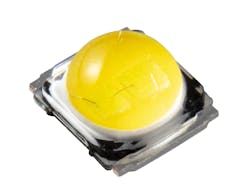Violet-pumped Nichia LED offers quality light and germicidal benefits
Nichia has announced a new LED, the NF2W585AR-P8, that it refers to as a dual-purpose LED intended to generate quality white light and fight bacterial pathogens. The LED is based on what the company calls a strong 405-nm pump in the violet region and Nichia phosphor technology that can deliver a uniform spectral power distribution (SPD) over the bulk of the human visual range. The product is intended primarily to defend against pathogens such as staph and E. coli.
The new Nichia LED is designed for use in what we initially had called continuous-disinfection applications, meaning that the deactivation spectrum would operate 24 hours a day as opposed to, say, using ultraviolet (UV) radiation in the UV-C band (100–280 nm) to instantaneously deactivate a pathogen. As we wrote last October, however, those continuous and instantaneous adjectives are no longer sufficient to describe a germicidal technology as some low-power UV-C systems are intended to operate continuously.
Nichia said the radiation produced by the violet pump in the new LED will deactivate bacteria such as Pseudomonas aeruginosa, Staphylococcus aureus (staph), and Escherichia coli (E. coli, O157). The company published test results performed at the Tokushima Prefectural Industrial Technology Center that indicate 1000 lx of radiation from nine of the LEDs at a distance of 40 cm deactivated 98.9% of Pseudomonas aeruginosa in five hours and 99.3% in 24 hours. Typically, you would see germicidal radiation dosage expressed in radiometric watts or mW, but here with the dual-purpose LED the characterization in lux is legitimate.
In announcing the new LED, Nichia made no claims about deactivation of the SARS-CoV-2 viral pathogen that causes COVID-19. Indeed, other purveyors of violet or UV-A-band (315–400 nm) disinfection lighting have also stayed away from SARS-CoV-2 claims. The fact is that the violet energy likely would deactivate such a viral pathogen, but would not do so quickly enough to prevent airborne transmission. But placed in a setting such as a locker room, the violet technology could quell staph problems. And in a medical facility, the violet energy could help fight healthcare-associated infections (HAIs). We covered research on UV-A technology being used in such healthcare settings last year.
The NF2W585AR-P8 LED is packaged in a 4×3.6-mm footprint. The company supplied us an SPD diagram (posted nearby) showing the strong violet peak as opposed to the typical blue peak in a phosphor-converted white LED. Relatively speaking, the violet intensity is more than 4× stronger than the blue intensity but in a region with diminished human eye sensitivity. And the peak is well below the circadian stimulus band, so it should not impact circadian health. You can also observe the relatively uniform SPD above 430 nm.
Nichia is not the first to use a violet pump in a white LED. Seoul Semiconductor has promoted its SunLike product for several years and touted a uniform SPD. But Nichia is stressing the dual functionality of its product.
Nichia will likely run into questions about the use case of its new LED and also about intellectual property (IP) issues. With the single LED delivering both the germicidal radiation and useful general illumination, the general lighting must be on for a luminaire to deliver germicidal benefits. We have seen other violet-based disinfection scenarios where a dual-LED-channel approach enables a facility to increase the violet energy and turn off the white radiation when people aren’t present in a space. That concept was presented by Vital Vio (now called Vyv) in a Strategies in Light talk back in 2017. Note that Vyv now calls the technology antimicrobial lighting.
As for the IP front, there are competing technologies and patents at play. Kenall Lighting was the first mover in the space and has defended its IP and challenged manufacturers using Vyv’s technology.
For up-to-the-minute LED and SSL updates, why not follow us on Twitter? You’ll find curated content and commentary, as well as information on industry events, webcasts, and surveys on our LinkedIn Company Page and our Facebook page.

Maury Wright | Editor in Chief
Maury Wright is an electronics engineer turned technology journalist, who has focused specifically on the LED & Lighting industry for the past decade. Wright first wrote for LEDs Magazine as a contractor in 2010, and took over as Editor-in-Chief in 2012. He has broad experience in technology areas ranging from microprocessors to digital media to wireless networks that he gained over 30 years in the trade press. Wright has experience running global editorial operations, such as during his tenure as worldwide editorial director of EDN Magazine, and has been instrumental in launching publication websites going back to the earliest days of the Internet. Wright has won numerous industry awards, including multiple ASBPE national awards for B2B journalism excellence, and has received finalist recognition for LEDs Magazine in the FOLIO Eddie Awards. He received a BS in electrical engineering from Auburn University.






